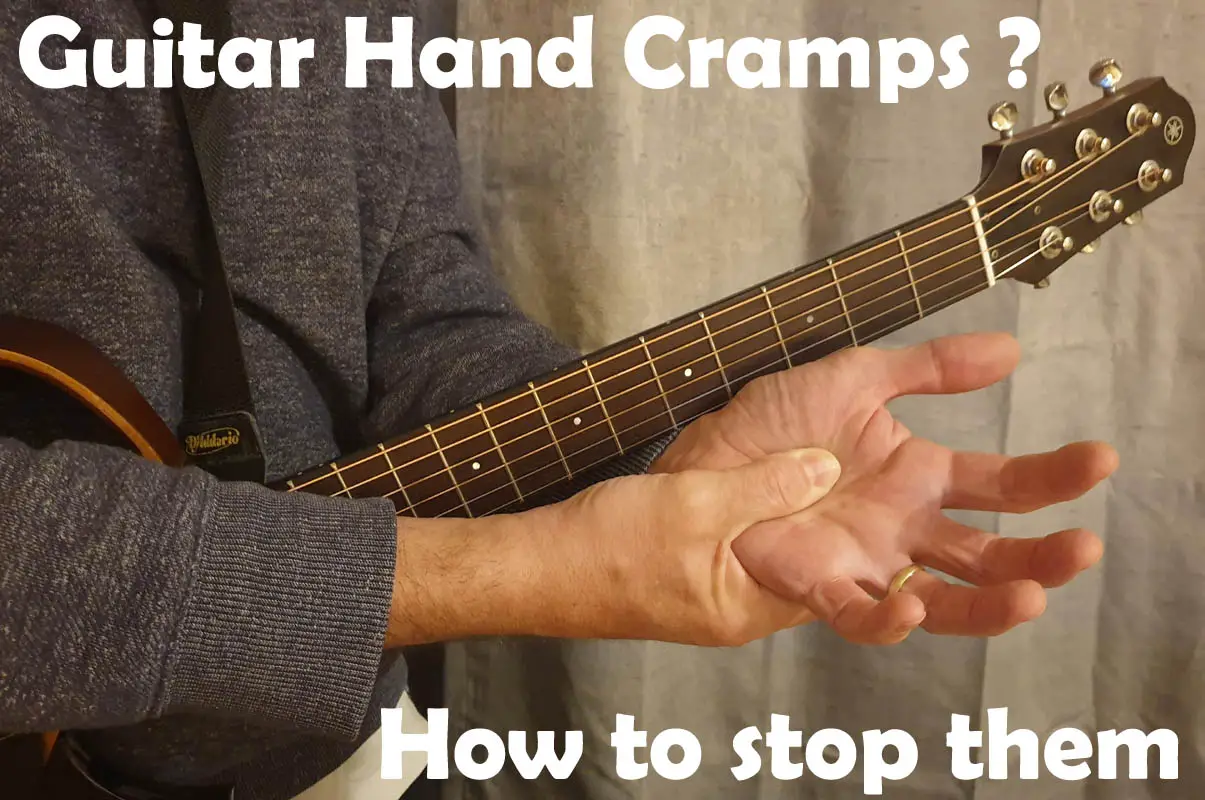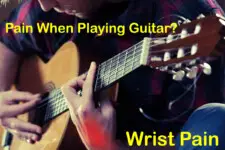Hand Cramps While Playing Guitar? How to Stop Them!
Everyone at some point in their guitar journey has experienced hand cramps, and it’s not just something that happens to beginners.
Lead guitar players can also experience cramping in their playing hand after fast solo’s and extended playing like at a gig.
Quite often new guitar players get them when learning to play barre chords. For others it’s because they already know some barre chords, haven’t played for a while, and get pain after a few minutes of constant playing.
Tension is the main reason guitar players get hand cramps, and this can happen in the fretting hand or the playing hand. The best way to avoid hand cramps is to warm up before playing, play regularly, and use less tension when playing guitar.
I can be a worry when you regularly get fretting or picking hand cramps from playing, and before the problem becomes more serious it’s a good idea to find ways to stop the problem

Why Does My Fretting Hand Cramp While Playing Guitar?
There are a few reasons why this can happen, with the most common reason being too much tension, meaning you are holding the strings down too hard.
Guitar Setup Problems
Sometimes the extra tension is caused by the way your guitar is set up, and you may find the action is set too high, or the strings are too heavy for your playstyle.
Acoustic guitars use thicker strings than electric guitars, so you are more likely to experience fretting hand cramping on an acoustic.
Wrist Angle
Another thing that can cause this issue is having a kinked wrist angle when playing.
Your wrist angle can be too sharp if you have small to medium hands, and like to wrap your thumb over the top of the fretboard. This causes a lot of tension through your wrist and fingers, as you struggle to get clear sounding chords.
Many people play this way because they see their favorite artists play this way, however if you don’t have large hands (long fingers) this method can cause playing issues.
Length of Play Time
Sometimes the above issues only come into play after extended playing, and just requires you to take a break to release the tension.
Why Does My Playing Hand Cramp While Playing Guitar?
Your playing (strumming or picking) hand is less likely to get cramps and pain due to a bad wrist angle.
When you have fingers flexed, under tension, and making rapid movements, these are the conditions that will cause problems.
Regular strumming with fingers is less likely to cause hand pain. Holding a pick between your thumb and forefinger with too much pressure while playing notes rapidly is normally the cause.
Flamenco guitarists are more likely to get this problem, as they play very fast.
How to Stop Hand Cramps When Playing Guitar
Here’s some general tips that help stop hand cramping in many cases.
Warm up & Stretch
This is the easiest thing to do. Just wiggle your fingers around to limber them up before playing, and if you are playing somewhere cold warm your fingers up before playing.
Some gentle stretches of both hands and fingers is also a great way to get ready for playing, and every guitarist should make a habit of doing this before every session. Just a couple of minutes is plenty, and the other benefit is that you will play better also.
Change Your Guitar Position
Are you playing with the neck too far forward or back? How about the angle up or down?
Changing the way your guitar sits can make a big difference to the tension in your hands and body, and particularly the angle of your fretting hand wrist.
If you play sitting down, then you may have become used to holding your guitar without a strap. Try using a strap even when you are sitting, as this takes away the need to hold the neck with your fretting hand, which reduces the amount of strength you use to play.
Some guitarists have also found that holding the guitar into your body more firmly can help reduce the clamping pressure needed with your fretting hand.
Change Your Fretting Pressure
Look carefully at your fretting technique, and experiment with how hard you actually need to hold the strings to get a good sound.
Practice finding the minimum amount of finger pressure you need for single notes and chords, and regularly checking your technique during your play session.
Take Breaks
If you’re getting cramps after playing constantly for 10-15 minutes or more, then try to take a break for 2-3 minutes, and shake your hands gently to loosen them up again.
How to Stop Hand Cramps Playing Barre Chords
Thumb Position
There is no exact right or wrong thumb position for playing, as we all have different sized and shaped hands.
So experiment with the position of your thumb on the neck for different shaped barre chords to see which gives you the easiest playing position while still sounding good.
You might find a new position reduces the strain on your wrist and hand.
Lower the Action
This applies more to acoustic guitars than electric guitars, due to their thicker strings.
If you hold each string down at the 3rd fret and can see a gap between the string and 1st fret larger than you can slip a business card through, then your action is way too high.
If the action is set correctly, the strings don’t have to be pushed down with as much pressure at the lower frets, making barre chords much easier there.
Fit Lighter Gauge Strings
Again, more for acoustic guitars than electric. If you are currently using a standard set of 12’s on your guitar, then try dropping to 11’s and see what the difference is.
Lighter strings have less tension and will make barre chords easier on your fretting hand, just note that they won’t be as loud as heavier gauge strings.
Learn Alternative Chord Types
Most people learn barre chords making a full bar across 5 or 6 strings with their index finger.
Advanced players know that this isn’t necessary most of the time, and there are other ways to play those chords without needing a full bar.
Check out some lessons online for finding other ways to play the chords that cause you the most tension. It’s a great way to avoid hand cramps, and you’ll find some awesome new chord voicings to use in your playing.
Stopping Guitar Picking Hand Cramps
Pick Holding Pressure
If you find yourself holding the pick too hard between your fingers when playing, this can be a major source of cramps.
Sometimes players hold the pick tightly to stop the pick slipping, and if this is you then try roughing up the surface of the pick with some coarse sandpaper to make it more grippy
Pick Thickness
Try using a thicker pick if you normally use a thin one. Picks around 1mm thick don’t flex too much, and so you will need less finger pressure to hold them steady.
Warm Ups
Warming up your wrist before playing can help you to keep playing for longer without cramping.
An online tip from a physical therapist is:
- Keeping your hand straight out, without moving your fingers move your wrist in tiny circles. Do this slowly!!
- Gradually get wider and wider until your wrist is making the biggest circles possible.
- Do this for about 30 seconds at a time.”
On a cold day make sure you warm your hands up first. You could use a hot pack, or just wash your hands under warm water.
Take Breaks & Loosen Up
In between songs put the pick down and shake your hand gently for a few seconds to relieve muscle tension in your hand.
Alternate Your Style
Learn to play some of your repertoire fingerstyle, and this will allow you to alternate the way you use your playing hand. This can be a great way to keep going for longer if you’re playing gigs where you can’t just stop when you want.
How Can I Relax My Hands While Playing Guitar?
Change Your Playing Posture
If you regularly practice sitting down, and get hand cramps after playing for a while standing up, stop and think about your posture.
If you notice tension in your shoulders, neck, or forearms, then this leads to increased hand tension. If you notice this, try moving your posture around to help alleviate stress.
Practice Checking Your Arm Tension
Every now and then during your playing, wriggle your elbow back and forth a little to see if you have started tensing your fretting arm too much. Keeping your arm relaxed will help reduce hand tension.
Practice Hand Independence
You might find when you start picking fast that the tension in your picking hand increases, and then subconsciously your fretting hand does the same.
Practice picking hard and then soft while thinking about your fretting hand, and learning to keep the tension independent between your hands.




